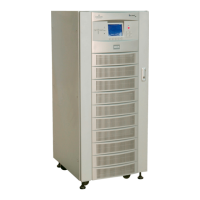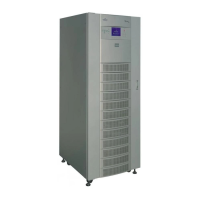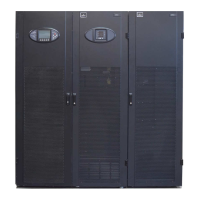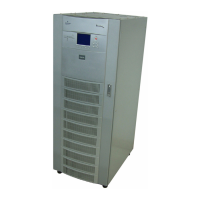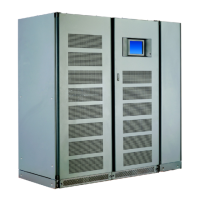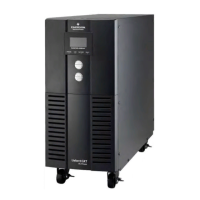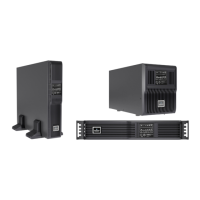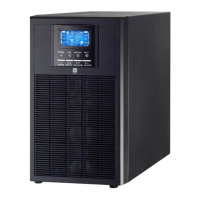Do you have a question about the Emerson Liebert NXC 60kVA and is the answer not in the manual?
Guidelines for safe installation and operation by professional engineers.
Environmental requirements for product storage and operation.
Emerson's liability for defects, malfunctions, and non-compliance.
Explanation of safety symbols used in the manual.
Compliance with CE, EMC, and specific UPS product standards.
Precautions regarding high earth leakage current and RCCB selection.
Highlights the UPS's ability to provide high-quality power and protect against input changes.
Explains the working principle of the single UPS module and its AC-DC conversion.
Details the AC-DC conversion and three-phase high frequency rectification process.
Describes the static switch function for bypassing loads during normal and overload conditions.
Explains normal operation, mains abnormal, and main recovery scenarios.
Explains the block diagram for UPS power supply switch configuration.
Describes the optional BCB for battery connection and overload protection.
Discusses hardware/software, cabling, and intelligent logic for parallel systems.
Lists requirements for parallel modules: rating, wiring, RCD, and inductors.
Details the UPS's available operating modes.
Describes normal operation where mains power is rectified and inverted to supply loads.
Explains battery mode where UPS provides backup power from batteries during mains failure.
Details automatic restart function after mains recovery or during load device failure.
Describes bypass mode for transfer during overload or shutdown, with minimal interruption.
Explains maintenance mode for manual bypass switch use during UPS maintenance.
Discusses ECO mode for energy saving, prioritizing bypass source when voltage/frequency are within limits.
Describes parallel redundancy for higher reliability and load sharing with up to four UPS modules.
Explains LBS mode for dual-bus systems, providing high reliability and suitability for multiple inputs.
Details frequency converter mode for fixed frequency output from variable input frequency.
Covers constant current charge, float charge, and automatic transfer to float charge.
Explains periodic UPS maintenance and battery self-test functions.
Describes how battery temperature compensation adjusts DC bus voltage to prolong battery life.
Covers battery low pre-warning, EOD protection, and BCB alarm.
General safety precautions and warnings for professional installation.
Recommends safe transportation methods and use of mechanical equipment for heavy UPS units.
Lists required tools for installation, including safety precautions for insulated tools.
Provides step-by-step instructions for unpacking the UPS, including removing panels and pallet.
Details pre-installation checks: environment, unpacking, and UPS verification.
Specifies requirements for UPS installation environment: temperature, humidity, and air quality.
Guidance on selecting a suitable location for the UPS, considering environmental factors.
Recommendations for battery placement considering temperature and ventilation.
Instructions for safe storage of the UPS, including temperature and ventilation requirements.
Specifies mechanical requirements for UPS installation, including clearances and cable access.
Provides warnings and cautions for safely moving the UPS cabinet.
Details clearance requirements for ventilation and access around the UPS.
Explains top and bottom cable access methods for UPS installation.
Step-by-step guide for positioning and fixing the UPS using adjustable feet.
Presents diagrams showing UPS dimensions and installation details.
Instructions for wiring power cables, including system configuration and cable selection.
Details power cable requirements for UPS input, bypass, and output connections.
Provides tables for maximum steady state AC and DC currents and bus stud specifications.
Specifies recommended CSA for UPS cables based on model and ambient temperature.
Guides the selection of UPS I/O switches based on actual usage needs.
Provides minimum distance requirements between UPS connection points and the floor.
General notes on cable selection, grounding, and connection for large cables.
Shows UPS power cable connection terminals and routing methods.
Explains protection ground connections for cables and cabinets.
Details the necessity of installing external circuit breakers for input and battery protection.
Instructions for installing protective devices for input supply and short circuit protection.
Requirements for RCCB installation for ground fault protection.
Describes the BCB's role in protecting the external battery and its functions.
Details protective device configuration for system output and overload protection.
Provides steps for connecting power cables, including routing and terminal connections.
Illustrates UPS power cable connection terminals and routing methods.
Introduces UPS signal cable connections for battery management, communication, and EPO.
Introduces UPS signal cable connections for battery management, communication, and EPO.
Details input dry contact ports J1 and J5 and their specifications.
Describes the BCB port (J2) and its function in battery control.
Explains the backfeed protection dry contact port (J3) and its warning.
Details the remote EPO input port (J4) for emergency power off functionality.
Describes the RS232 communication port for parameter settings and connection.
Explains the USB communication port for monitoring and software updates.
Details the RS485 communication port, including pin definitions and cable diagrams.
Lists optional Intellislot ports and their models and installation positions.
Provides steps for connecting signal cables, including routing options.
Introduces the operator control and display panel, covering LCD screen, indicators, and keys.
Defines the status and description of inverter and alarm indicators.
Lists different alarm sounds and their corresponding meanings.
Describes the function of each control key on the operator panel.
Explains the LCD screen layout and the function of menu keys (F1-F5).
Details the different LCD screen types and their displays.
Shows the initial start screen displayed after UPS self-test.
Details the primary screen layout, including system, data, menu, and keypad windows.
Describes the default screen displayed during UPS operation and how to return to it.
Provides detailed descriptions of items in the system information, menu, and data windows.
Explains prompts and their meanings displayed during UPS operation.
Lists UPS alarms, their descriptions, and explanations.
Introduces operating precautions and methods for UPS operation.
Safety precautions for initial power-on, operation, and hazardous voltage warnings.
Identifies the power switches (Q1-Q6) on the front door and their functions.
Details the procedures for starting up the UPS under various conditions.
Step-by-step guide for starting the UPS in normal mode, including warnings.
Instructions for starting the UPS in ECO mode, requiring service engineer configuration.
Procedure for starting the UPS from battery mode, including cold start.
Details the procedures for transferring the UPS between different operation modes.
Steps for transferring from normal mode to battery mode, including power re-connection.
Procedure to transfer from normal mode to bypass mode using the OFF key.
Steps to transfer from bypass mode back to normal mode.
Procedure to transfer from normal mode to maintenance bypass mode.
Steps to transfer from maintenance mode back to normal mode.
Explains how to perform battery tests, including preconditions and test procedure.
Details the procedure for performing UPS self-tests and interpreting results.
Details procedures for safely shutting down the UPS.
Steps for completely powering down the UPS, including safety precautions.
Explains the procedures for using the EPO function in various scenarios.
Steps for resetting the UPS after an EPO event and resuming normal operation.
Describes the automatic restart function after mains failure or during EPO.
Instructions for selecting the display language on the UPS LCD.
Procedure for setting the current date and time on the UPS.
Details how to change the control password for UPS operation and self-tests.
Introduces UPS battery composition, safety, installation, and maintenance.
Safety precautions for working with batteries, including high voltage warnings.
Discusses valve-regulated batteries, gas escape, and battery temperature effects.
Guidance on battery installation design, referencing external battery manuals.
Specifies ambient temperature range and ventilation requirements for battery installation.
Provides a table for the number of batteries based on UPS voltage ratings.
Explains the role of the internal fuse, BCB, and EPO button in battery protection.
Steps for installing batteries, ensuring proper gap, order, and gravity center.
Instructions for connecting batteries in series/parallel, polarity, and cable bending radius.
Guidance on battery room design, including layout, workbench, wiring, and BCB.
Details the optional BCB box, its components, and parameters.
Provides recommended BCB rated current and battery discharge current.
Instructions for battery maintenance, including screw tightening and cleaning.
Guidelines for the environmentally responsible disposal of used batteries.
Overview of parallel system and LBS system, their configuration, and connections.
Details installation procedures for parallel UPS systems.
Checks for correct parallel cable selection and module rating before installation.
Instructions for cabinet installation and interconnection for maintenance and testing.
Guidance on power cable wiring for bypass and rectifier input terminals.
Instructions for connecting shielded and double-insulated parallel cables.
Explains the remote EPO function for each UPS module and the system.
Details operation procedures for parallel UPS systems.
Step-by-step guide for starting the UPS in normal mode, including warnings.
Procedures for using maintenance bypass switches in parallel UPS systems.
Steps to safely isolate a single UPS module from a parallel system.
Steps to insert an isolated UPS module back into a parallel system.
Instructions for completely powering down UPS modules in a parallel system.
Details the LBS system, its components, and operation.
Details LBS system cabinet installation for single and parallel UPS systems.
Refers to external protective device selection for LBS systems.
Guidance on power cable for dual-bus power systems, similar to single systems.
Instructions for connecting LBS cables in ring configurations for UPS modules.
Lists available UPS options, remarks, and model numbers.
Introduces the functions and installation of various optional components.
Details the bypass load sharing inductor kit for parallel UPS systems.
Tools and materials required for installing bypass load sharing inductors.
Steps for installing bypass load sharing inductors, including safety warnings.
Diagrams and instructions for connecting bypass load sharing inductors.
Information on internal battery kits and their parameters.
Tools and materials for installing internal batteries.
Steps for installing internal batteries, including shutdown and LCD checks.
Details the battery temperature compensation kit and its connection.
Information on seismic anchor kits for UPS earthquake/vibration protection.
Tools and materials for installing seismic anchor kits.
Steps for installing seismic anchor kits, including foot removal and anchor placement.
Description and appearance of the IS-UNITY-DP card.
Details the IS-WEBL card for network management and environment monitoring.
Tools and materials for installing the IS-WEBL card.
Steps for installing the IS-WEBL card, noting it is hot-pluggable.
Details the IS-Relay card for monitoring UPS via dry contact signals.
Describes the IS-485L card for Modbus RTU protocol conversion.
Refers to Section 6.9 for BCB Box information.
Availability of parallel cables in various lengths.
Availability of LBS cables in various lengths.
Using IS-WEBL card for SNMP communication with the UPS.
Using IS-485L card for Modbus communication with the UPS.
Provides two dry contact communication approaches: IS-Relay card and dry contact port.
Using IS-Relay card for dry contact signals and monitoring.
Using external interface board ports for status information and EPO.
Safety warnings for inspection and replacement of UPS components.
Information on key UPS components and their estimated service life.
Table of key components, estimated life, proposed replacement time, and inspection period.
Instructions for replacing air filters, including frequency and cleaning.
Guidance on replacing fuses on copper bars at battery input terminals.
General maintenance tips: good history records, cleaning, ambient conditions, and wiring checks.
Lists European and international standards the UPS complies with.
Specifies environmental characteristics like noise, altitude, humidity, and temperature.
Details mechanical characteristics such as dimensions, net weight, and protection degree.
Specifies electrical characteristics of the input rectifier, including voltage, frequency, and distortion.
Details electrical characteristics of the intermediate DC circuit, including charging and boost control.
Specifies electrical characteristics of the inverter output, including power factor and overload.
Details electrical characteristics of the bypass input, including voltage tolerance and synchronization.
Provides efficiency and loss data for the UPS at different load levels.
